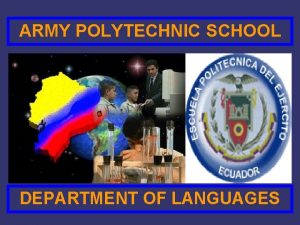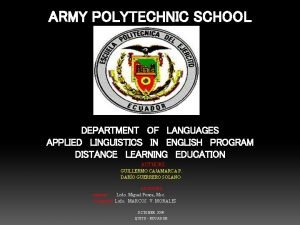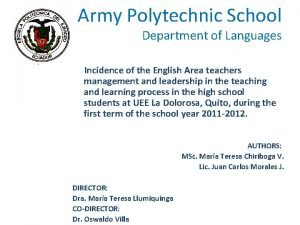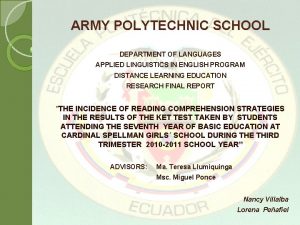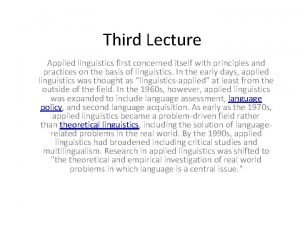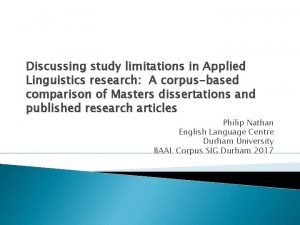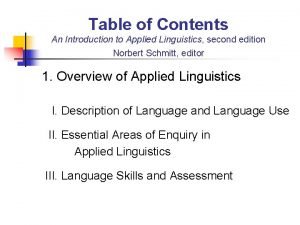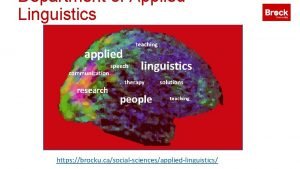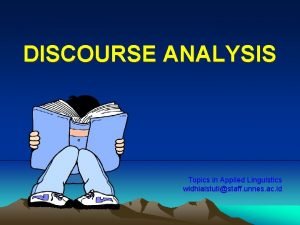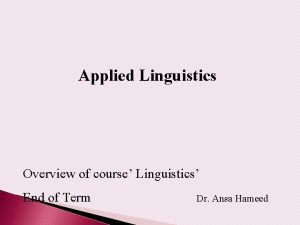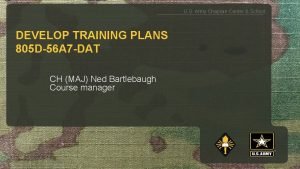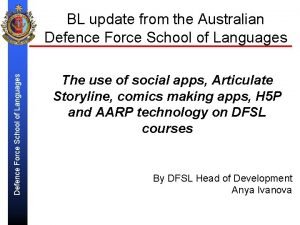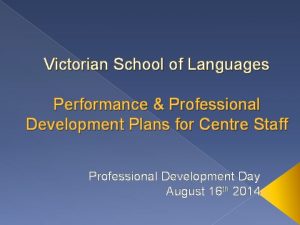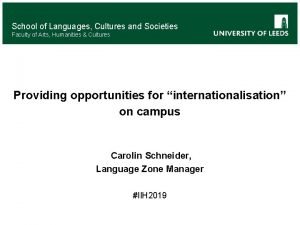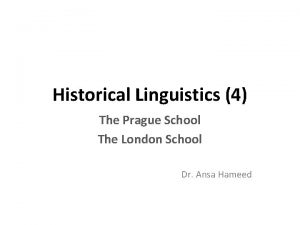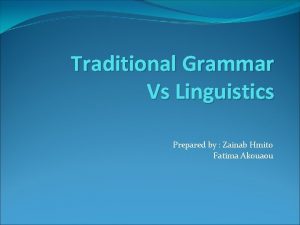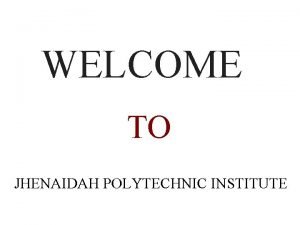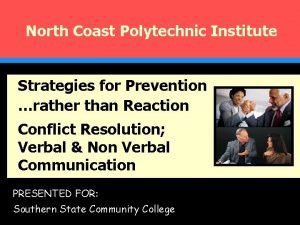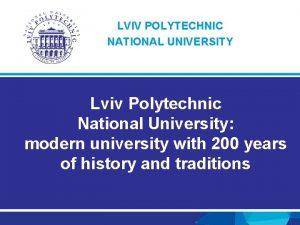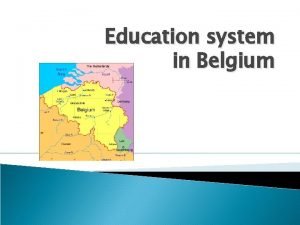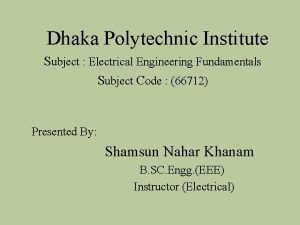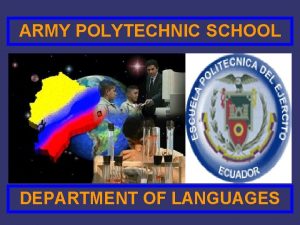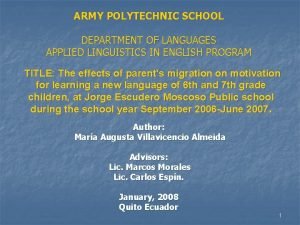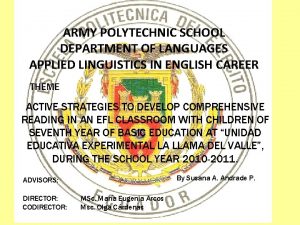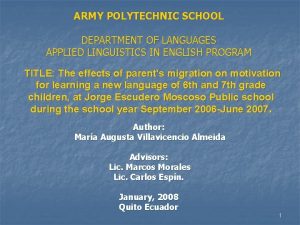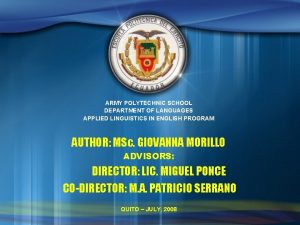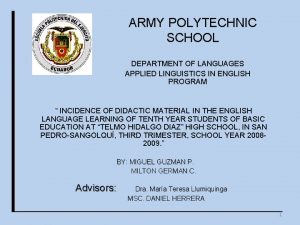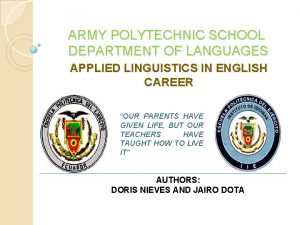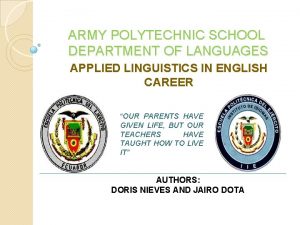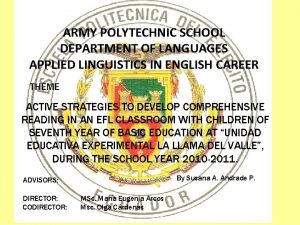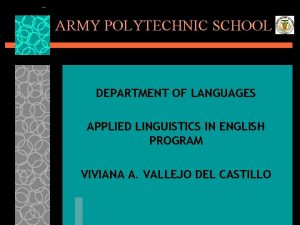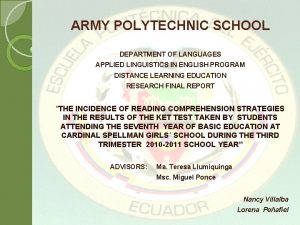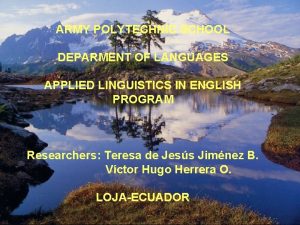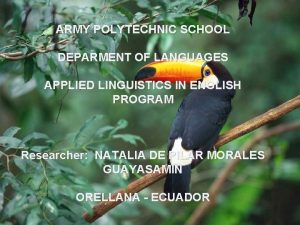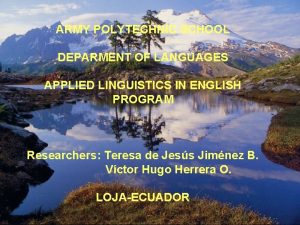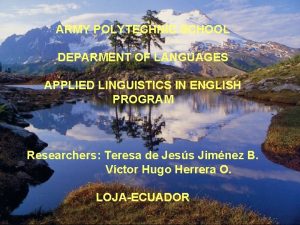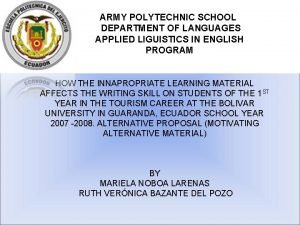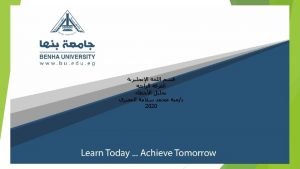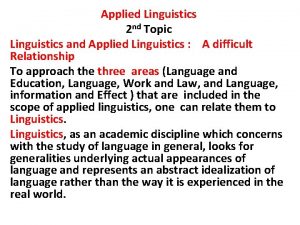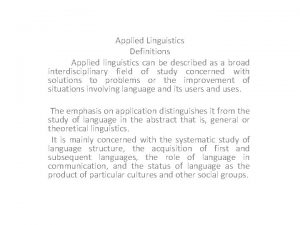ARMY POLYTECHNIC SCHOOL DEPARTMENT OF LANGUAGES APPLIED LINGUISTICS


























- Slides: 26

ARMY POLYTECHNIC SCHOOL DEPARTMENT OF LANGUAGES APPLIED LINGUISTICS IN ENGLISH PROGRAM “STUDY OF FLIGHT OPERATIONS AND AERONAUTICAL INFORMATION SERVICE AREAS AT THE COTOPAXI INTERNATIONAL AIRPORT TO DETERMINE THE AERONAUTICAL TECHNICAL ENGLISH REQUIREMENTS FROM OCTOBER- 2009 TO JANUARY-2010” AUTHOR: MARÍA GABRIELA RÍOS TORO DIRECTOR: CO-DIRECTOR: Dr. Ma. Eugenia Arcos Jiménez M. Sc. Lic. Marcos Morales. JANUARY- 2010 QUITO – ECUADOR

INTRODUCTION: PART I Research Problem PART II Theoretical Frame PART III Methodological PART IV Conclusions Design PART V Proposal and Recommendations

PART I Problem Identification : Causes Effects FO area doesn’t know the Aeronautical Technical English requirements. • Bad quality of service to the foreign crews. • AIS area doesn’t know the Aeronautical Technical English requirements. • To proportionate aeronautical information with mistakes and fails. • Actually those areas do not give the complete and appropriate Aeronautical Technical English Information. • Don’t improve the quality of service to the foreign flight crew’s.

PART I GENERAL OBJECTIVE: To study the Flight Operations and Aeronautical Information Service areas at the Cotopaxi International Airport to determine the Aeronautical Technical English requirements.

SPECIFIC OBJECTIVES: To study the organization and functioning of both areas at the Cotopaxi International Airport. To study Inward Technical documentation of both areas, that the personnel have to receive from the foreign flight crews. (W&B) and (FPL) respectively. To study Outward Technical documentation of AIS area, that the aeronautical personnel have to proportionate to the foreign flight crews. (PIB) and (METAR).

PART I Independent variable: - Flight Operations and Aeronautical Information Service areas. -Dependent variable: - Aeronautical Technical English requirements.

JUSTIFICATION: Aeronautical Technical English knowledge level of the personnel is limited. There is not a normal and safety advising foreign flight crews. It is necessary to have a real support to answer the doubts of the foreign flight crews. The benefits of the present research work will be significant for aeronautical technicians doing our job.

PART II – THEORETICAL FRAME INTERNATIONAL CIVIL AVIATION ORGANIZATION - ICAO v. AIM: The aim of the ICAO shall be to safeguard international civil aviation flight operations following with the security rules and standards around the world. v. ORGANIZATION: The ICAO constitutes an international organism which Organic structure is composed by: AN ASSEMBLY – A COUNCIL – A GENERAL SECRETARY v. MAIN OBJECTIVE: To develop the principles and techniques of the international air navigation with security and establish the development of the air transport.

PART II– THEORETICAL FRAME CIVIL AVIATION DIRECTION - DAC v. AIM: The DAC aim is to adopt the internationals norms and recommended methods which ICAO indicates through its normative. v. ORGANIZATION: The Civil Aviation Direction constituents a national organism. The central office is in Quito- Ecuador. v. MAIN OBJECTIVE: The objective is to regular, establish, and control all the security aeronautical rules in the aerodromes of the Ecuador country.

PART II – THEORETICAL FRAME INTERNATIONAL COTOPAXI AIRPORT AIM: It is through the Headquarter administration, who takes charge of human resource, physical and economics airport purposes. ORGANIZATION: The airport is administrated by the Civil Aviation Direction. It has three areas: OPERATIVE – ADMINISTRATIVE- GENERAL S. MAIN OBJECTIVE: To control correctly the air transport, guaranteeing an efficient, regular, feasible set or environment to the clients.

PART II – THEORETICAL FRAME FLIGHT OPERATIONS AREA (FO) v. AIM: To takes charge to the control and the execution of the Technical Civil Regulations of the Ecuador country. RDAC. v. ORGANIZATION: It is taken charge by the Airport Headquarter. It is conformed by three Flight Operations Inspectors. v. MAIN OBJECTIVE: To guarantee the safety and security of flight operations at the Cotopaxi International Airport.

PART II– THEORETICAL FRAME AERONAUTICAL INFORMATION SERVICE AREA – (AIS) v. AIM: To proportionate all kind of aeronautical information to the foreign flight crews. v. ORGANIZATION: At the Aeronautical Information Service Area works three technicians whose are taken charge by the Airport Headquarter. v. MAIN OBJECTIVE: To proportionate the aeronautical information before and after of the flights, guaranteeing the safety and security of given information.

PART II – THEORETICAL FRAME AVIATION CARGO COMPANIES - CARGOLUX AIRLINE q. The company operates in the International Cotopaxi Airport since 2000. q. Cargolux is one of the leading cargo airlines worldwide. q. The international company has a fleet of 16 B 747 -400 freighter aircrafts covering over 90 destinations around the world. q. The company carries: General cargo specially tropical flowers, perishables, temperature sensitive goods, live animals, dangerous goods.

PART II – THEORETICAL FRAME AVIATION CARGO COMPANIES - CARGO B AIRLINE q. Cargo B is an airline based in Brussels, some destinations all over the world. q. The company started to operate in the Cotopaxi International Airport since January of 2008. q. The Cargo B Airlines fleet operates the following aircraft 2 Boeing 747200 F and 1 Boeing 747 -400 F. q. The mainly goods that the Cargo B transport are mixed perishables including flowers, living horses, trucks, cars parts and machinery.

PART III – METHODOLOGICAL DESIGN Methodology Scientific method Modality of the research EXPLORATIVE type method. Type NON- EXPERIMENTAL and DOCUMENTAL one. • Establishment of the problem that require its development. The research was developed in three phases: • Study of the material, bibliography related with the research. • Proposal which is the elaboration of the guide.

CONCLUSIONS: The elaborated guide of Flight Operations and Aeronautical Information Services areas was projected with the real necessity of aeronautical technical English used. According with the study the technical personnel of both areas will dominate the requirements that we need to know in the elaboration of our diary job.

RECOMMENDATIONS: The utility of this guide resides in the truthfulness of the information, that is why necessary the permanent upgrading according with the structure, functions, rules, normative, regulations, and dispositions dictated by the Aeronautic authority. To motive the Flight Operations and Aeronautical Information Service areas technicians the permanent capacitating in the aeronautical technical English language and improve the quality of service.

PROPOSAL A GUIDE OF FLIGHT OPERATIONS AND AERONAUTICAL INFORMATION SERVICE AREAS TO SATISFY THE AERONAUTICAL TECHNICAL ENGLISH REQUIREMENTS OF THE FOREIGN FLIGHT CREWS TRAINING.

INFORMATIVE DATA INSTITUTION: International Cotopaxi Airport LOCATION: Av. Amazonas LA FAE site AERODROME NAME: LATACUNGA/Cotopaxi. Intl. OACI TECHNICAL INDICATOR: SELT SCHEDULES: ADMINISTRATIVE SCHEDULE: MON / FRI de 1300 – 2130 UTC. TECHNICAL SCHEDULE: 1045 – 0500 UTC.

AERONAUTICAL TECHNICIANS’ BRIEFING. DEVELOPMENT OF THE SEMINAR AERONAUTICAL TECHNICAL ENGLISH REQUIREMENTS Day 1 -Goals/Objectives of the Seminar -Technical Data of the Cotopaxi International Airport -Concepts -Aeronautical English Requirements -Results

AERONAUTICAL TECHNICIANS’ BRIEFING. DEVELOPMENT OF THE SEMINAR AERONAUTICAL TECHNICAL ENGLISH REQUIREMENTS Day 2 -Technical Documentation -Concepts -Principles -Aeronautical English Requirements -Results

AERONAUTICAL TECHNICIANS’ BRIEFING DEVELOPMENT OF THE SEMINAR AERONAUTICAL TECHNICAL ENGLISH REQUIREMENTS Day 3 -Inward Technical Documentation -Concepts -Flight Plan and Weight and Balance Load sheets. -Aeronautical English Requirements -Results

AERONAUTICAL TECHNICIANS’ BRIEFING DEVELOPMENT OF THE SEMINAR AERONAUTICAL TECHNICAL ENGLISH REQUIREMENTS Day 4 -Outward Technical Documentation -Concepts -Previews Information Bulletin and Meteorological Reports. -Aeronautical English Requirements -Results

AERONAUTICAL TECHNICIANS’ BRIEFING DEVELOPMENT OF THE SEMINAR AERONAUTICAL TECHNICAL ENGLISH REQUIREMENTS Day 5 -General Information -Concepts -Principles -Aeronautical English Requirements -Results

AERONAUTICAL TECHNICAL GUIDE q TECHNICAL DATA q TECHNICAL DOCUMENTATION OUTWARD TECHNICAL DOCUMENTATION ( PIB AND METARS ) INWARD TECHNICAL DOCUMENTATION ( FPL AND WB ) GENERAL INFORMATION (INSTALLATIONS, WORKING HOURS)

THANK YOU FOR YOUR ATTENTION!
 Theoretical linguistics vs applied linguistics
Theoretical linguistics vs applied linguistics Army polytechnic school
Army polytechnic school Army polytechnic school
Army polytechnic school Army polytechnic school
Army polytechnic school Army polytechnic school
Army polytechnic school Traditional linguistics and modern linguistics
Traditional linguistics and modern linguistics Characteristics of applied linguistics
Characteristics of applied linguistics Interdisciplinary branches of linguistics
Interdisciplinary branches of linguistics Scope of applied linguistics
Scope of applied linguistics Example of scope and limitation
Example of scope and limitation Applied linguistics
Applied linguistics Brock university applied linguistics
Brock university applied linguistics Applied linguistics
Applied linguistics Content and discourse analysis
Content and discourse analysis Applied linguistics
Applied linguistics Combined arms training strategies
Combined arms training strategies Defence school of languages
Defence school of languages Victorian school of languages
Victorian school of languages Tandem language
Tandem language Prague linguistic school
Prague linguistic school Prague school of linguistics
Prague school of linguistics What are the inadequacies of traditional grammar
What are the inadequacies of traditional grammar Jhenaidah polytechnic institute
Jhenaidah polytechnic institute North coast polytechnic institute
North coast polytechnic institute National university polytechnic institute
National university polytechnic institute 6th grade in belgium
6th grade in belgium Dhaka polytechnic institute code
Dhaka polytechnic institute code

